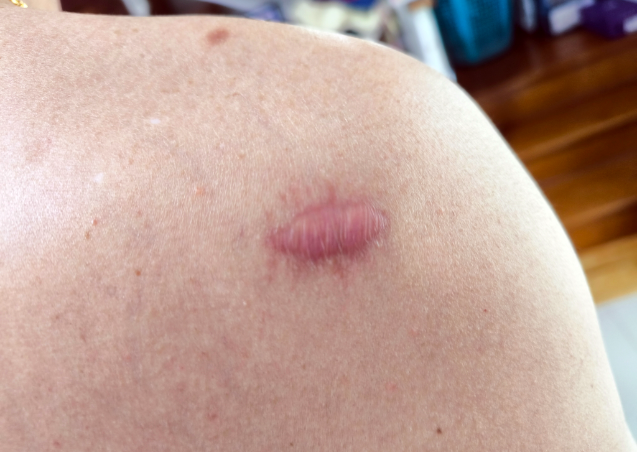Keloid

A keloid scar is defined as excessive scar tissue that grows beyond the borders of the original incision or wound. Keloid results from abnormal wound healing process which causes excess collagen deposition; and excess of type 3 collagen is found in keloids. Lesions may develop as early as 1- 3 months or late as one year after injury.
Keloids present clinically as firm, rubbery nodules that project above the underlying skin in an area of prior injury to the skin. Colour ranges from erythematous, flesh coloured or hyperpigmented and colour may change with evolution of the keloid scar. Patients are usually asymptomatic, but some patients may complain of pain, tenderness (pain on touch), itching and burning sensation. These scars rarely regress with time and need treatment.
Platelet Rich Plasma is an autologous product and is relatively safe with minimal adverse effects.
Predisposed individuals may develop keloid following any level of skin injury that includes :
Multiple treatment modalities are available for treatment of keloids. We at Zoe Aesthetic usually combine intralesional steroids and ablative lasers like CO2 and Er: YAG to achieve very satisfactory results in the treatment of keloids.
Intralesional corticosteroids are considered the first line of treatment for keloids scars. Multiple injections at intervals of 4 to 6 weeks are required. This therapy is used alone or in combination with other modalities like laser. Most commonly used steroid is Triamcinolone (kenalog). It works by reducing the inflammation,suppressing the immune response, and inhibiting excessive production of collagen which is the key factor to formation of keloid.
Laser Scar Revision of keloid is a nonsurgical procedure to improve the appearance, symptoms, texture & pliability of a keloid with lasers. Laser Scar Revision utilizes photothermal energy to target intra and extracellular structures within the keloid scar tissue to stimulate the remodeling of dermal collagen and elastin and also causes neo epithelization of targeted keloid scar tissue. Ablative lasers are most important tools for non surgical scar revision of keloids.
Most commonly used ablative lasers are CO2 and Er:YAG Lasers.
More recently, fractional ablative laser resurfacing (Fractional CO2 laser treatment) & (Fractional Er:YAG laser treatment) has emerged as a popular treatment modality for keloid scars because of better patient acceptability and tolerability due to reduced downtime. In Fractional Ablative Laser Resurfacing, columns of thermal damage called microscope thermal treatment zones are separated by surrounding untreated skin.
This results in rapid re-epithelization and reduced downtime as only fraction of the skin is treated. The micro thermal treatment zones also allow fractional lasers to penetrative the skin more deeply than the fully ablative lasers. Studies have also shown significantly superior outcome with fractionated CO2 and Er:YAG lasers compared to fully ablative CO2 & Er:YAG lasers for surgical and traumatic scar revision.
There are other treatment options to treat keloids which are not effective and has a high chance of recurrence or carries a risk of serious adverse effects. These procedures are not performed at Zoe Aesthetic.
These options include Surgical Excision, Cryotherapy and Radiotherapy.
Due to high recurrence rate of between 45% to 100% this method is not performed alone is paired with an adjunctive therapy like radiotherapy and intralesional steroids.
FAQs